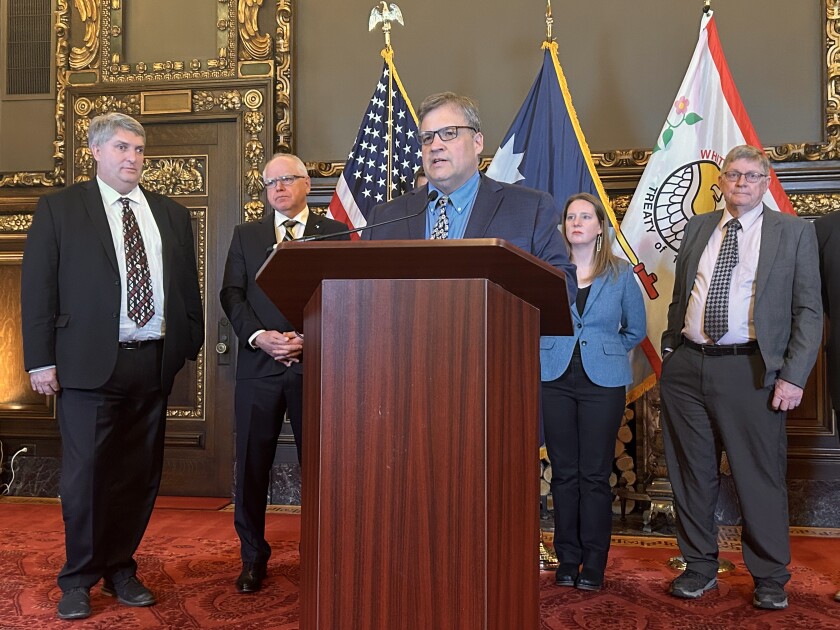ST. PAUL — Shortly after the Minnesota Board of Animal Health quarantined a Stearns County dairy herd after samples collected as part of the state’s milk surveillance plan tested positive for H5N1, a strain of highly pathogenic avian influenza, state leaders held a news conference to address avian flu.
Gov. Tim Walz took to the podium Wednesday at the Minnesota State Capitol with Minnesota’s Agriculture Commissioner Thom Petersen, Minnesota State Veterinarian Brian Hoefs and the Minnesota Department of Health Senior Infectious Disease Epidemiologist Malia Ireland to discuss the state’s response.
Funding
Petersen said the state Legislature provided an ag emergency account of $4 million to help deal with avian influenza, and that account is down to between $1 million to $2 million, depending on how much money will be reimbursed by the USDA.
Included in the governor's budget proposal is an additional $4 million to help with surveillance, salaries for responders, equipment maintenance and depopulation, if needed. Walz added that he expects the USDA to be able to assist with indemnity compensation for depopulation .
"It's a tough time to be in agriculture right now, and it's tough in Minnesota where we've gone from droughts to floods, and we have avian influenza , and we have trade uncertainties that play a role in this," Walz said. "I think the one consistent piece of this is that our producers know, and the people of Minnesota know, there is a unified front around biosecurity and protection of our agricultural business and the health of Minnesotans that is still very strong."
Petersen remarked that three years ago Wednesday, the state had its first case of avian influenza for that year. Before that, cases were found in the state in the first weeks of spring in 2015. Petersen said the state is familiar with what to do in this situation from those experiences.
"Minnesota is very well prepared in dealing with this because of what we went through in 2022, when we had over 100 cases that spring," he said.

The virus has changed since then, he said, and the state needs to prepare for a deluge in cases to respond appropriately, even when there's not currently a case of avian influenza in poultry in the state.
"We declared Friday as being free of HPAI," Petersen said. "But we're watching the migration very closely. I live on a river, and my anxiety level goes very high when I see the swans and the geese and everything that are returning at this time."
ADVERTISEMENT
Hoefs said declaring the state's poultry free of HPAI to this point is a "small victory" and to expect more cases to come this spring.
"We hold our breath knowing that it's short-lived and the migratory season is upon us. That's when we expect this virus to return, and we are right on the cusp of it," he said. "I'm hearing from my colleagues in some of our Southern states, central Midwestern states, that are talking about the invasion, I'll call it. So we are bracing ourselves, but we will enjoy a brief period of quiet."
Protecting state's dairy, poultry industries
"Minnesota is No. 1 in turkey production, and we're in the top 10 in dairy production, and so our issue is where a lot of our dairy cows are, a lot of our poultry is," Petersen said.
Hoefs said the state has tested nearly 90% of Minnesota's dairy herd and only ended up with one detection of avian influenza. He and Petersen emphasized that pasteurized milk and properly prepared meat are safe to consume.
"The USDA and the FDA have been testing that, and the routine surveillance has not found any danger to the public in pasteurized milk and properly cooked meat, too," he said. "We have tested almost 1,500 dairy farms in the last three weeks, and we've had the one positive sample, and we'll continue testing those," he added, referencing the Stearns County case.
Petersen said work among state agencies is crucial to stop any spread of avian influenza.
"That partnership piece is very critical between the Department of Health, the Board of Animal Health, the USDA, and the different agencies in Minnesota, whether that's Fish and Wildlife Service, veterinarian services, FSA, and then the University of Minnesota is also a very key partner in this," he said.












